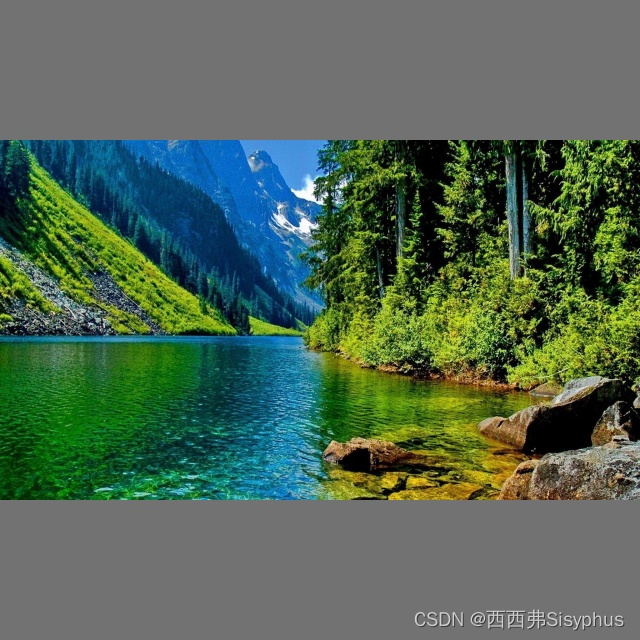-
目标检测 YOLOv5 - 模型推理预处理 letterbox
目标检测 YOLOv5 - 模型推理预处理 letterbox
flyfish
版本:YOLOv5 6.2
假如图片大小是1080 * 1920 (height * width )
width = 1920
height = 1080当模型输入是 640 * 640时
shapes = (1080, 1920), (0.33, 0.33), (0.0, 140.0)640/ 1920 = 0.33
图片缩放到 360 * 640 (height * width )

当前 模型 输入 必须 640 * 640 时
就将 360 * 640 的图片 装进 640 * 640中
多余的部分都是灰色边框
140是图片上下边框各自的高度

当模型输入 不必须 640 * 640 时
可以做成填充最小矩形灰色边框能被32整除
360 / 32 = 11.25
384 / 32 = 12
360 * 640 变成了 384 * 640

这样图片上下有很少的灰色边框
1080 * 1920 (height * width )变 360 * 640 (height * width )def load_image(self, i): # Loads 1 image from dataset index 'i', returns (im, original hw, resized hw) im, f, fn = self.ims[i], self.im_files[i], self.npy_files[i], if im is None: # not cached in RAM if fn.exists(): # load npy im = np.load(fn) else: # read image im = cv2.imread(f) # BGR assert im is not None, f'Image Not Found {f}' h0, w0 = im.shape[:2] # orig hw r = self.img_size / max(h0, w0) # ratio if r != 1: # if sizes are not equal interp = cv2.INTER_LINEAR if (self.augment or r > 1) else cv2.INTER_AREA im = cv2.resize(im, (int(w0 * r), int(h0 * r)), interpolation=interp) return im, (h0, w0), im.shape[:2] # im, hw_original, hw_resized return self.ims[i], self.im_hw0[i], self.im_hw[i] # im, hw_original, hw_resized- 1
- 2
- 3
- 4
- 5
- 6
- 7
- 8
- 9
- 10
- 11
- 12
- 13
- 14
- 15
- 16
360 * 640 (height * width )变 384 * 640 (height * width )
def letterbox(im, new_shape=(640, 640), color=(114, 114, 114), auto=True, scaleFill=False, scaleup=True, stride=32): # Resize and pad image while meeting stride-multiple constraints shape = im.shape[:2] # current shape [height, width] if isinstance(new_shape, int): new_shape = (new_shape, new_shape) # Scale ratio (new / old) r = min(new_shape[0] / shape[0], new_shape[1] / shape[1]) if not scaleup: # only scale down, do not scale up (for better val mAP) r = min(r, 1.0) # Compute padding ratio = r, r # width, height ratios new_unpad = int(round(shape[1] * r)), int(round(shape[0] * r)) dw, dh = new_shape[1] - new_unpad[0], new_shape[0] - new_unpad[1] # wh padding if auto: # minimum rectangle dw, dh = np.mod(dw, stride), np.mod(dh, stride) # wh padding elif scaleFill: # stretch dw, dh = 0.0, 0.0 new_unpad = (new_shape[1], new_shape[0]) ratio = new_shape[1] / shape[1], new_shape[0] / shape[0] # width, height ratios dw /= 2 # divide padding into 2 sides dh /= 2 if shape[::-1] != new_unpad: # resize im = cv2.resize(im, new_unpad, interpolation=cv2.INTER_LINEAR) top, bottom = int(round(dh - 0.1)), int(round(dh + 0.1)) left, right = int(round(dw - 0.1)), int(round(dw + 0.1)) im = cv2.copyMakeBorder(im, top, bottom, left, right, cv2.BORDER_CONSTANT, value=color) # add border return im, ratio, (dw, dh)- 1
- 2
- 3
- 4
- 5
- 6
- 7
- 8
- 9
- 10
- 11
- 12
- 13
- 14
- 15
- 16
- 17
- 18
- 19
- 20
- 21
- 22
- 23
- 24
- 25
- 26
- 27
- 28
- 29
- 30
- 31
-
相关阅读:
[操作系统笔记]两级页表
微信小程序点单左右联动的效果实现
使用流量转移完成金丝雀部署
【数学建模】matlab向量(数组)
15 软专
使用html展示中秋节快乐的脚本
Win11怎么修改关机界面颜色?Win11修改关机界面颜色的方法
Sklearn基础教程
【Unity实战100例】Unity幸运大转盘之概率可控
CSS入门学习笔记例题详解
- 原文地址:https://blog.csdn.net/flyfish1986/article/details/127450753